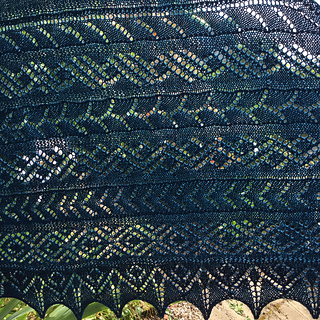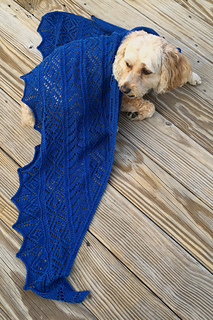patterns >  Susan Goldstine's Ravelry Store
Susan Goldstine's Ravelry Store
> Linear Lace








Linear Lace
Notions:
Scrap yarn
Crochet hook for provisional cast on with scrap yarn, size C—G (2.75—4mm)
Stitch markers (optional)
Stitch holder (optional)
Yarn needle
Scissors
Waterproof pins for blocking (and/or
lace blocking wires)
Linear Lace is an asymmetrical triangular shawl that incorporates all seven frieze symmetry types, that is, all of the types of symmetries that repeat along a single line. The seven lines of lace trail up the right side of the triangle.
You knit six of these symmetry patterns side-by-side in the main body of the shawl, which starts long and tapers to a point, making the knitting quicker and quicker as you go along. Then, you pick up along the right edge and add a lace edging containing the seventh pattern. Finally, the left edge is finished with a simple garter border.
To successfully knit this shawl, you will need to read a charted pattern, work traditional knitted lace (yarn overs and various decreases as charted), make a provisional cast on (video instructions are linked), pick up and knit (instructions included), and do a k2tog bind off (instructions included).
The design of Linear Lace incorporates ideas from mathematical symmetry theory. For those knitters who would like to learn more about this theory, the pattern includes a supplementary section with a breakdown of the symmetry types in the shawl. For more examples of similar demonstrations by myself and other designers and artists in knitting, embroidery, bobbin lace, temari, and bead crochet, check out my paper A Survey of Symmetry Samplers from the proceedings of the 2017 Bridges Conference on mathematics and the arts.
Thanks to all my amazing test knitters, who helped make this a pattern that I am proud to offer to you. Proceeds from the pattern sales will be donated to the Association for Women in Mathematics, a non-profit organization that supports equal opportunity for girls and women in all levels of mathematical endeavor.
142795 projects
stashed
108398 times
7995 projects
stashed
8234 times
4456 projects
stashed
4550 times
2509 projects
stashed
4561 times
- First published: July 2017
- Page created: July 19, 2017
- Last updated: October 5, 2019 …
- visits in the last 24 hours
- visitors right now




